Average Wage Trends Inside and Outside Indiana
Average wages per job have become one of the leading factors of concern for economic developers, as well as politicians. Legislation has targeted average wages. Often those laws require that new jobs exceed the average wage in the place where those jobs are to be located. We need to realize that if a new job pays $8 per hour and replaces a job that pays $6 per hour, the average wage will rise.
This article presents the latest data from the U.S. Bureau of Economic Analysis on average wages per job for the United States and Indiana’s 92 counties. (These data are not adjusted for inflation.)
Indiana Among the States
The average wage per job in the United States was $36,167 in 2002; in Indiana, it was $31,975, or 11.6 percent below the national figure. With the exception of California, the highest paying jobs are found in the Northeast. The lowest paying jobs range more widely, from New Mexico and Idaho to Maine (see Figure 1).
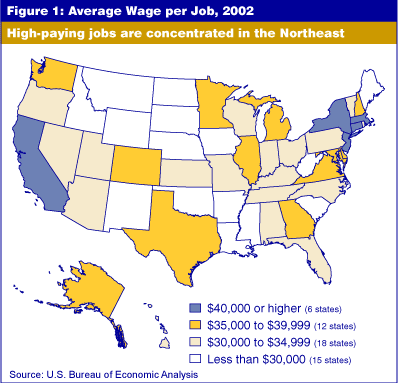
Indiana’s position relative to the nation has been slipping during much of the past 10 years. While we recovered faster than the United States after the 1990–91 recession, we did not participate as well in the boom of the late 1990s and fared worse than the nation in the recent recession. The up-tick in 2002 might be a good sign if sustained (see Figure 2).
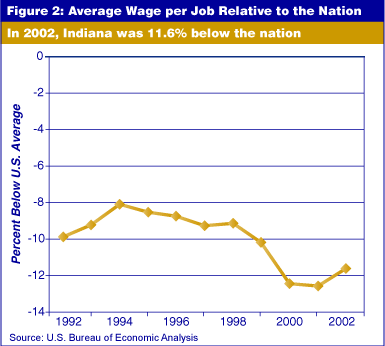
Our decline in relative position is caused by growing slower than the nation, as seen in Figure 3. From 1992 to 1997, Indiana averaged 3.36 percent annual increases in average wages compared to the national rate of 3.22 percent.
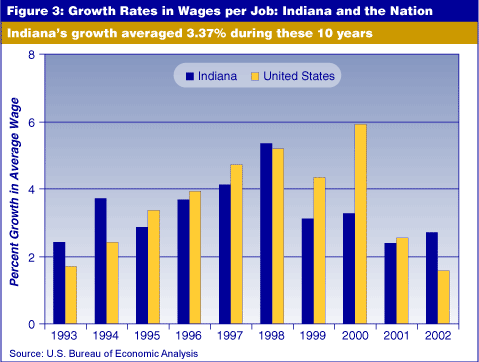
This was good enough for us to be ranked 23rd in the United States. In the next five years (1997 to 2002), our growth edged up to 3.37 percent, but the nation advanced at a 3.91 percent rate, so Indiana’s rank fell to 42nd among the 50 states. For the 10-year period from 1992 to 2002, average wages per job in the nation grew by 3.57 percent (see Figure 4), while Indiana’s growth was an average of 3.37 percent (35th among the 50 states).
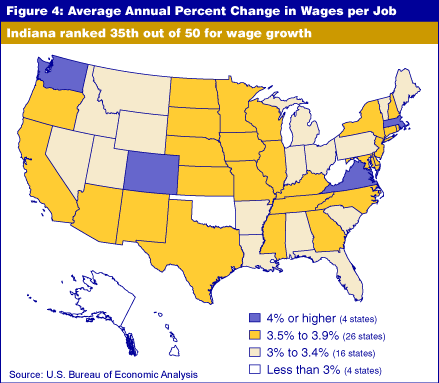
Counties of Indiana
Hoosiers who have been following the recent discussions concerning the Crane Naval Surface Warfare Center will understand that in 2002, the highest wages per job in Indiana could be found in Martin County. From 1992 to 2002, Martin County realized an average rank of 2.00 in the state, second only to Howard County which came in with an average rank of 1.27. While the statewide average was $31,975, Martin County was at $41,783, or 30.7 percent above the state figure. Of the nine counties more than 5 percent above the state figure, only two were in the Indianapolis metropolitan area (Hamilton and Marion). High-wage jobs are found in Posey, Ripley, Gibson, Bartholomew and Vermillion counties—not necessarily where we might expect them until we think about which firms are located in those counties.
Most of the state (75 counties) was below the statewide figure (see Figure 5). The lowest paying jobs were in Brown County at $20,034, which might be influenced by seasonal employment in tourism and retail trade. Normally, Hoosiers divide the state between north and south with I-70 or U.S. 40 as the separator. Yet, 11 of the lowest 13 counties in average wages are west of U.S. 31; perhaps the time has come to think of the state differently.
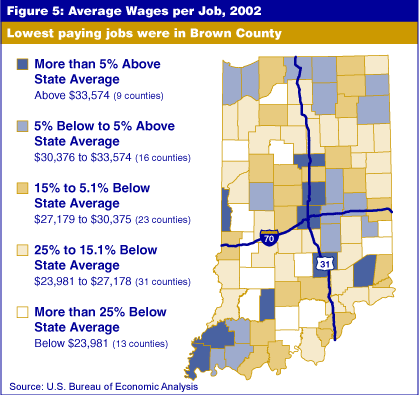
Are the counties with high wages diverging from those with low wages? One way to answer that question is to look at the highest and lowest counties, shown in Figure 6 using the left axis. On the right axis is the ratio of those two numbers. The general trend of that ratio is downward, signifying that the spread between the highest and lowest counties is decreasing over time.
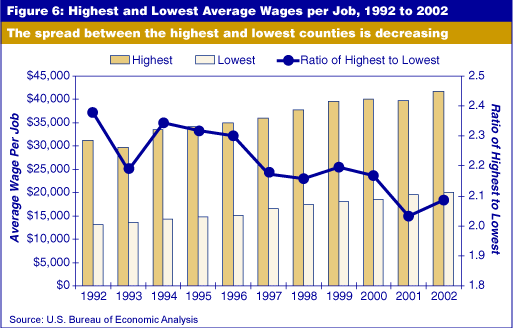
Another way to answer that question is to look at the correlation coefficient between the level of wages in 1992 and the rate of growth from 1992 to 2002. For Indiana that coefficient was -0.45, which is not a strong statistical value, but does show the tendency for lower wage counties to have faster rates of growth than the higher wage counties. (Nationally, the correlation coefficient was +0.06, which is totally insignificant and suggests no relationship at all between the level of wages in a state and the rate of growth experienced by the state.)
Between 1992 and 2002, 36 of Indiana’s 92 counties exceeded the nation’s average annual growth rate of 3.57 percent. At the same time, 52 counties exceeded the state’s 3.37 percent average growth rate. As seen in Figure 7, some of the counties with the slowest growing wages are also some of the most populous in the state (Lake, Porter, La Porte, Delaware and Madison). By contrast, counties with the fastest growing wages are among the least populous in the state (Ohio, Gibson, Switzerland and Union). Two of these have benefited from riverboats while another has seen the establishment of a major auto assembly plant. These are examples of state economic development programs at work.
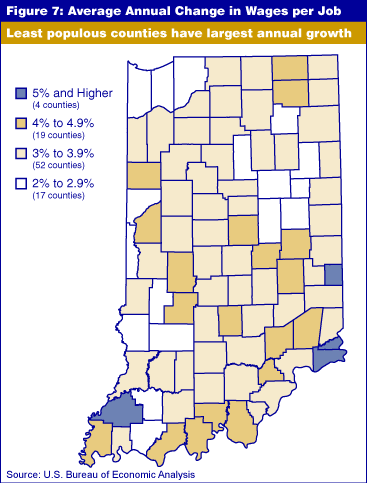
![]()
Morton J. Marcus
Director Emeritus, Indiana Business Research Center,
Kelley School of Business, Indiana University
